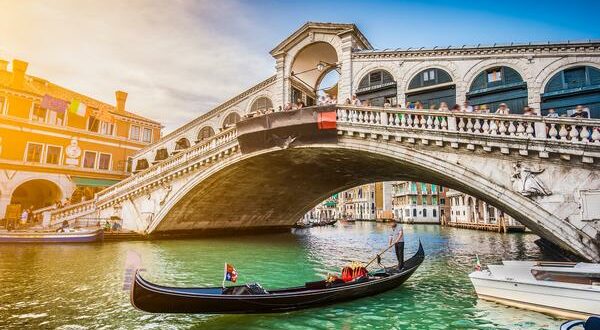[ad_1]
Venice’s celebrated canals have dried up severely after weeks of abnormal winter weather conditions, making it impossible for the city’s gondolas, water taxis and other boats to navigate the iconic waterways.
Rather than facing the perennial flooding that’s typical at this time of year, the ancient city faces an opposite dilemma: a prolonged period of atypically low tides causing critically low water levels that have reduced some of its 150 canals to mere muddy pits.
The phenomenon is being blamed on the combination of a few factors, with a lack of rain, a lingering anticyclone weather system and abnormal sea currents being among them. According to CBS News, environmental scientists confirmed that climate change has contributed to the anomalous high and low tides at this time of year.
A high-pressure anticyclone weather system that’s sat over Western Europe for the past 15 days is producing mild temperatures that are usually seen only in late spring. On top of which, the Alps—whose snowmelt constitutes a critical water source in the spring and summer months—have received less than half of their normal snowfall this winter, according to scientists and environmental groups.
Besides being an emblematic cultural component, Venice’s famed canals support one of the famously sinking city’s primary transportation systems, being routinely plied by gondolas and other waterborne conveyances.
The situation has raised concerns that Italy may face another drought on the scale of last summer’s water shortage, its worst in 70 years, which prompted the government to declare a state of emergency for areas surrounding the River Po, Italy’s longest river and a major water source for roughly one-third of the nation’s agricultural production.
The Po currently holds 61 percent less water than is usual at this time of year, according to the Italian environmental association Legambiente, which raised the alarm this week that the country’s lakes and rivers are suffering from a severe water shortage.
Venice has long been known for its perennial flooding, but now it’s facing the opposite problem: Low tides have left the ancient city with low water and dry canals, making many of its famous waterways unnavigable. https://t.co/ceIT05Eg0d
— CBS News (@CBSNews) February 23, 2023
Meanwhile, the Italian Alps are presently packing approximately 53 percent less snow than they’ve averaged in winter over the past decade, while Italy’s nationwide snow deficit now stands at roughly 45 percent, Legambiente said in a statement.
Alpine snow represents the country’s primary water reserve, as meltwater flows into the Po River, which runs from the Alps down to the Adriatic Sea through Italy’s most populated regions.
“We are in a water deficit situation that has been building up since the winter of 2020-2021,” said Massimiliano Pasqui, a climate expert with Italy’s National Research Council (CNR), according to CNN. “We need to recover 500 millimeters in the northwestern regions: We need 50 days of rain,” he added.
Fortunately, forecasts suggest that some precipitation is on the way to Venice and surrounding areas over the coming week, hopefully depositing some snow in the Alps. Whether it will be enough to see the city’s water-going vessels once again afloat remains to be seen.
For the latest travel news, updates and deals, be sure to subscribe to the daily TravelPulse newsletter here.
[ad_2]
You can read more of the news on source
 Travelsmart
Travelsmart



